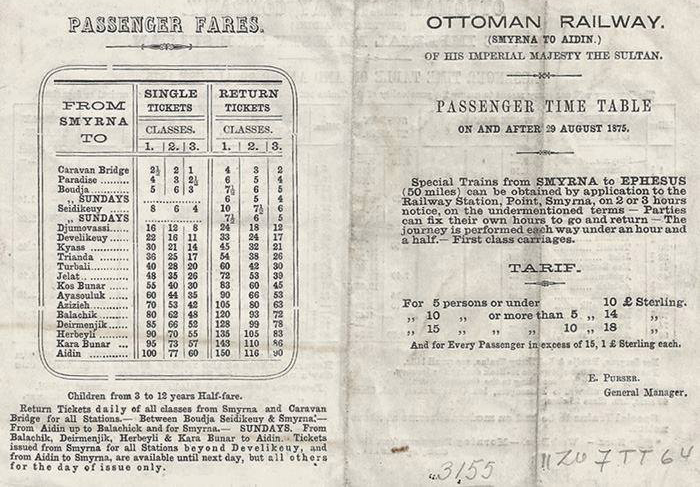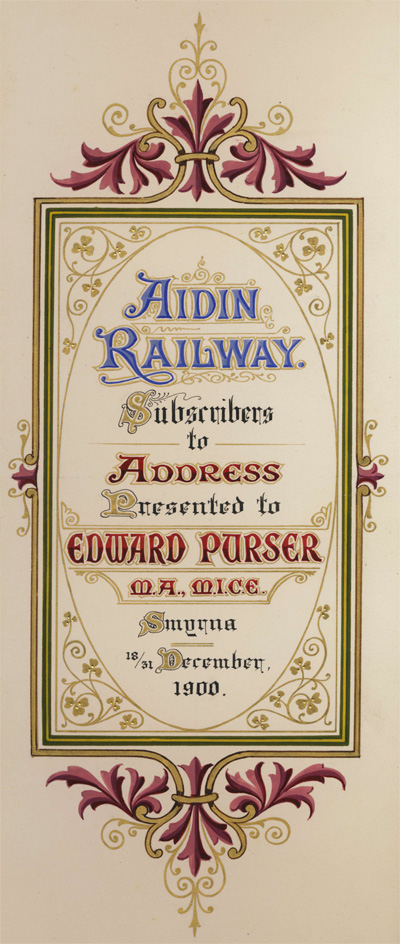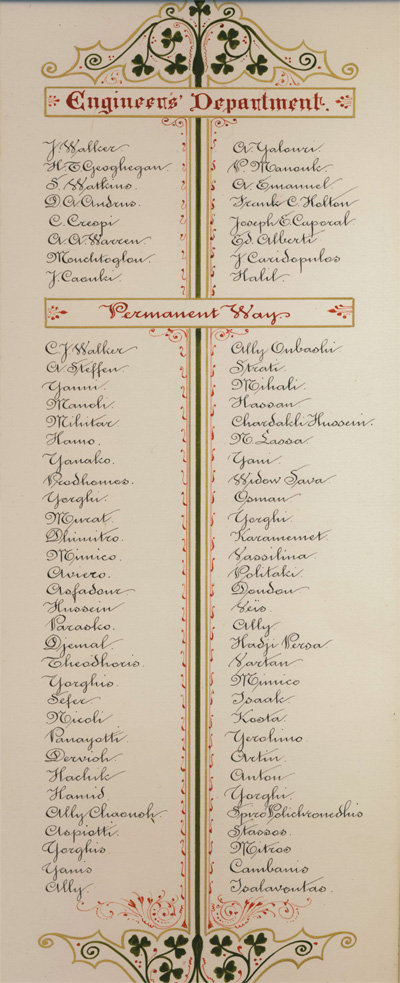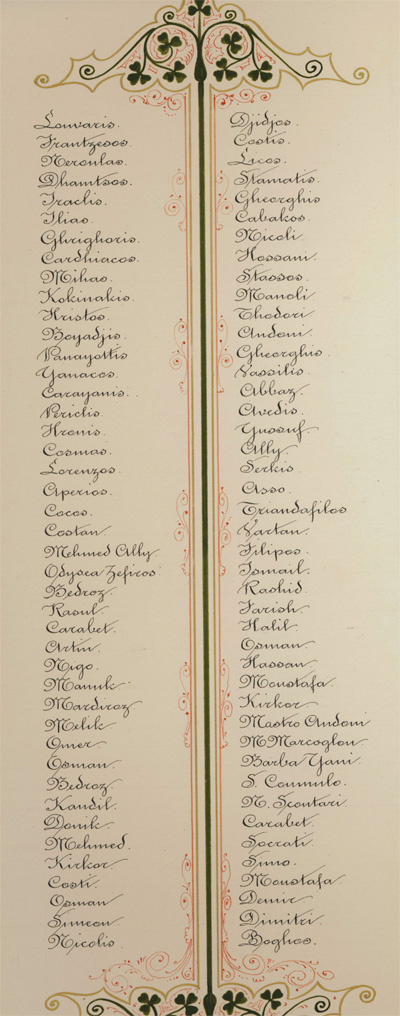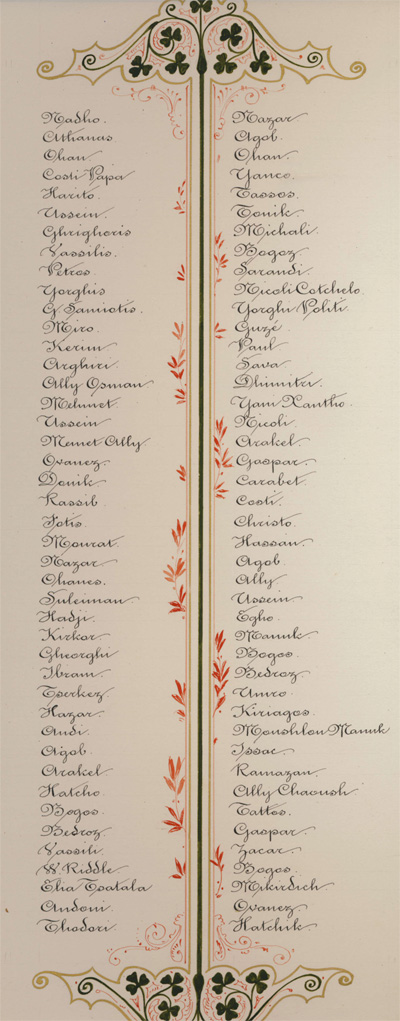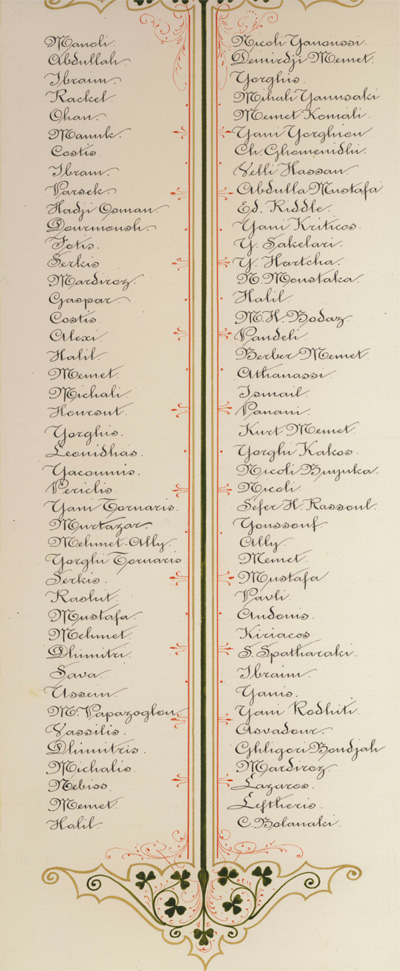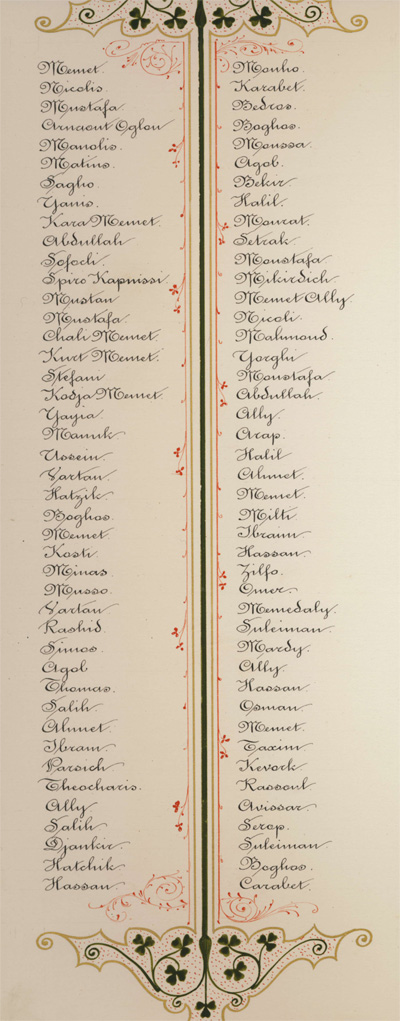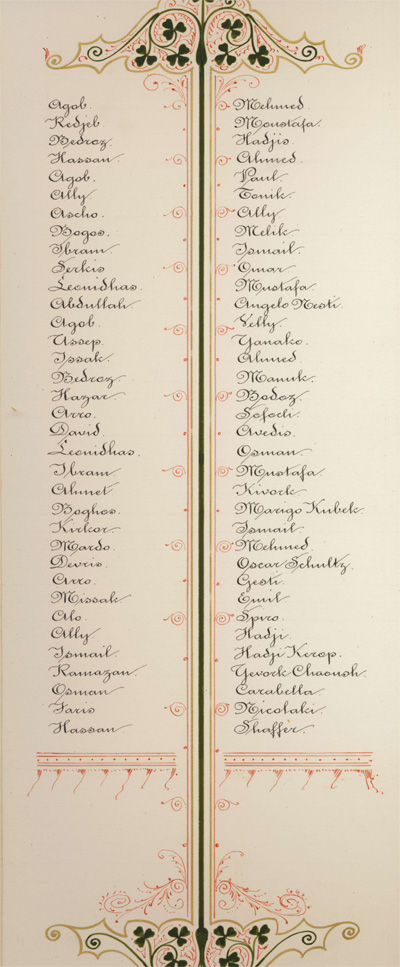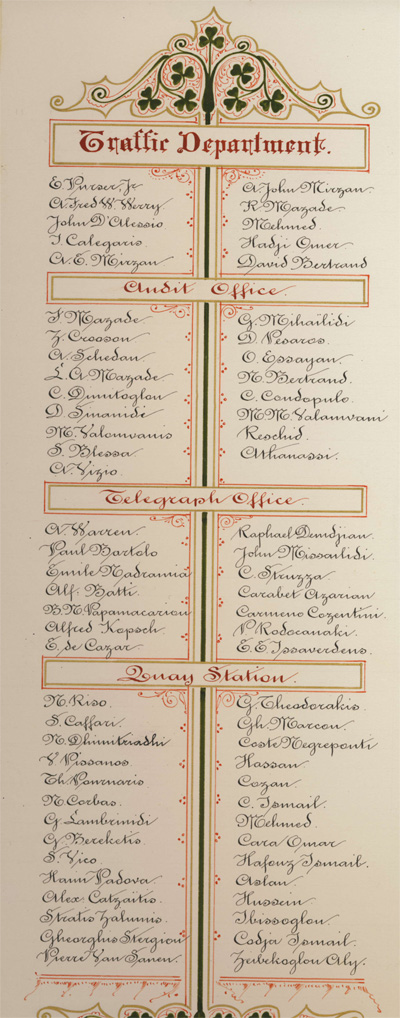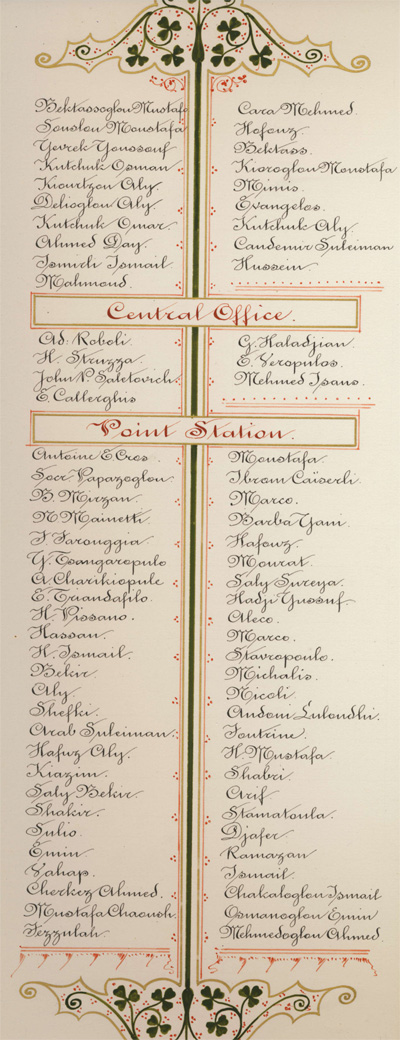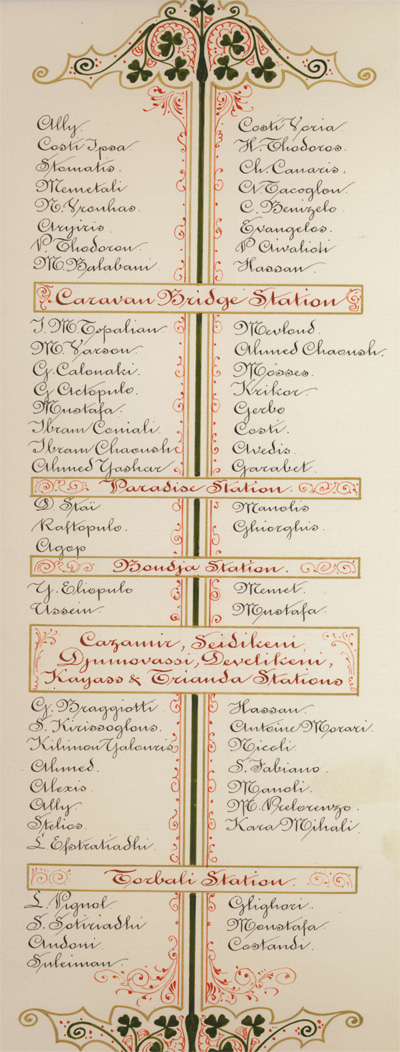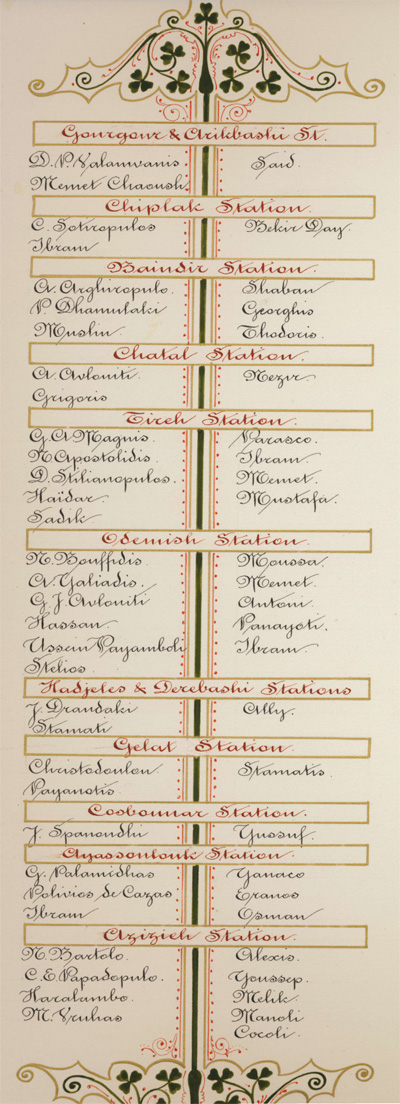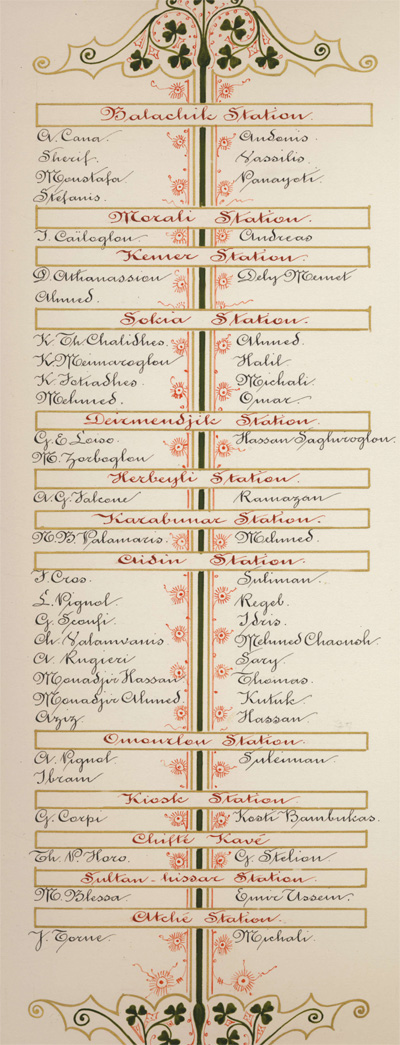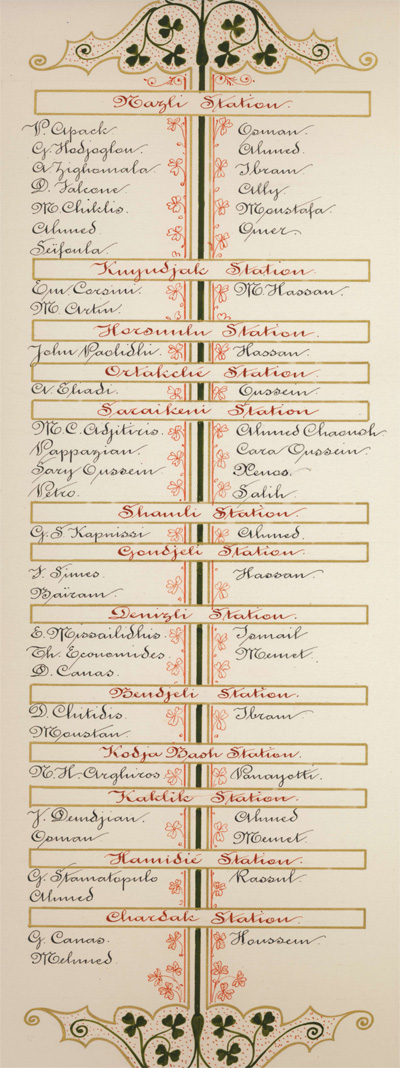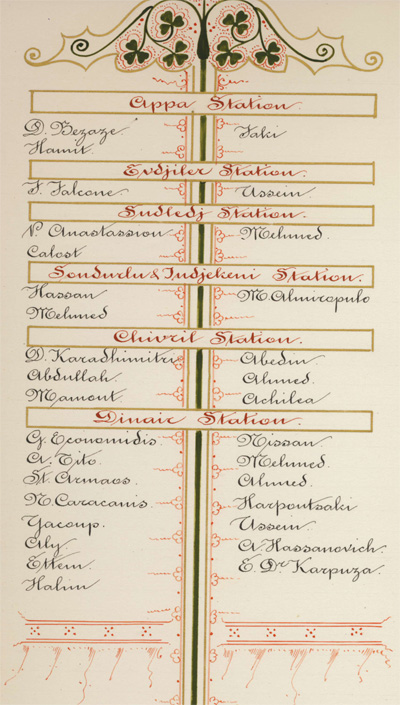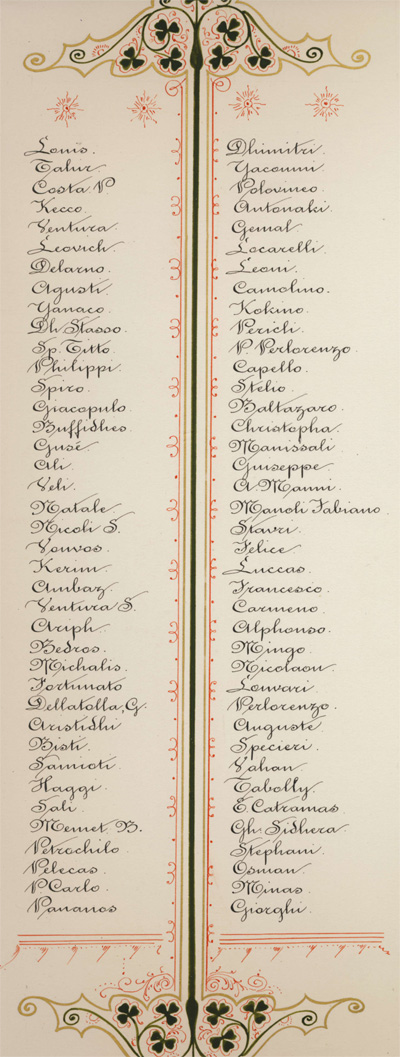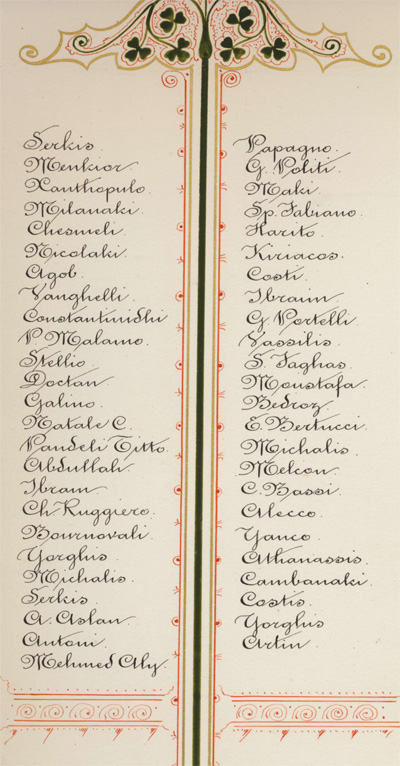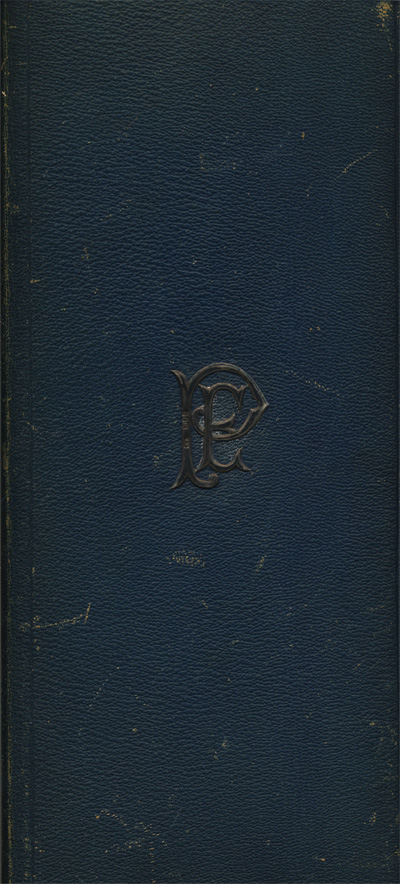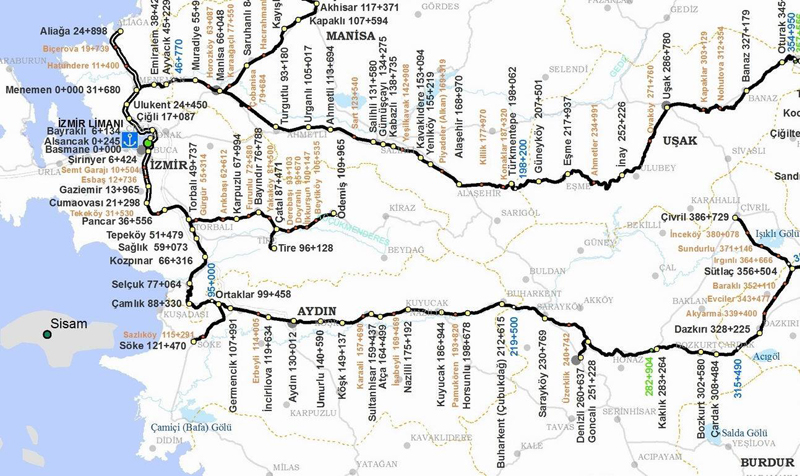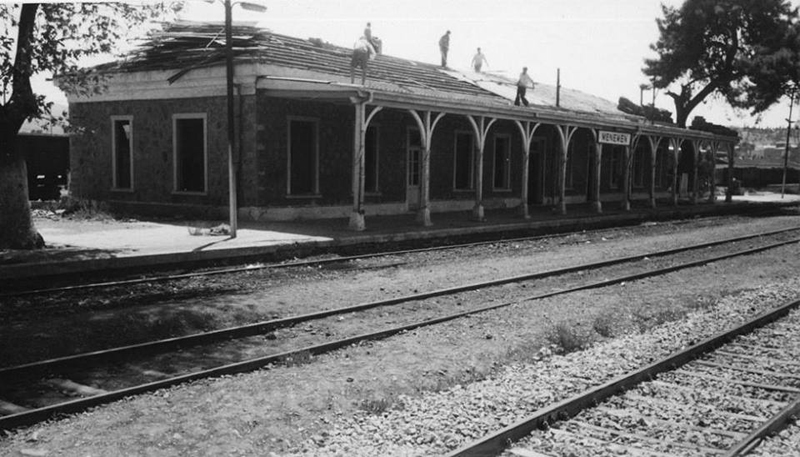
Ephemera
ORC Personnel listing
The Ottoman Railway Company was also known as the Smyrna-Aidin Railway and was one of the foreign operated railway lines emanating from the major port of Smyrna. This was the oldest railway in Anatolia, built by a British consortium to transport mineral and fruits (primarily figs) from the Aydın plain to the Port of Smyrna to be exported.
The ORC concession was given by the Ottoman Government on September 22, 1856 to build and operate the line between Smyrna and Aydın. The concession was to last for 50 years from October 1, 1860, the date originally agreed for the opening of the line. The intention of the company was to carry minerals and agricultural goods from the rich Menderes Valleys to the port of Smyrna. However, this traffic was not enough to generate big revenues and the ORC was never highly profitable. One way out would have been to extend the network to the Anatolian Plateau, but the ORC failed to secure the concession to extend to Konya or to Afyon. Indeed railways concession were highly political, the British voters were not keen for their government to help the Ottomans building railways that might compete with other British interest in India and in the Middle East. Consequently, the ORC acted very much like a colonial railway and because of poor Ottoman planning, the ORC could play no role at integrating various large city such as Izmir with Konya. In addition the damage to railway lines, bridges and stock in the 1919-22 Greek-Turkish war took place largely in this area and many costs had to be written off. The ORC continued to operate as a regional railway up until 1935, when the Turkish State Railways absorbed it. Further information: dissertation:
Edward Purser of Anglo-Irish origin was the general manager and chief engineer for the Ottoman Railway Company till he retired in 1900, after 40 years of service, when as gratitude the company presented this book with the personnel of the company at the time indicated. This provides a good snapshot of the staff, their rough positions and general indicators of ethnicities. We can assume this was done on a voluntary ‘opt-in’ basis as it is defined as ‘subscribers to address’, done over 13 days with all the various stations covered. One can assume the vast majority of the staff would have consented to this move as not only was Purser considered very competent and so popular, but job security concerns would be an additional impetus in demonstrating this loyalty. The majority of the names are indicated merely as first (this was standard practice for the Moslem Turkish population at the time) or surnames, so for the Christian work-force, this suggests this is how some of the employees were happy to be recorded as.
Analysis work done by site contributor Anna Laysa di Lernia on the names from this listing with origins from the region of Trani in Southern Italy, July 2024: - in Italian:
The engineering department seems to be comprised of Anglo-Levantines (Walker, Watkins, Warren, Holton, Andrus, Geogheyan), some Italian Levantines (Crespi, Alberti), many Greeks (Emanuel, Monchtoglou, Caonki, Yalouzi, Manouk, Caridopulos) and possibly one Turk (Halil). The remainder staff was around 60% Greek as these names suggest, the remainder Turks (~25%) and a scattering of Levantines and virtually no Jews. So the ethnic breakdown of the workforce roughly corresponded with that of the Smyrna region of the time, with perhaps a slight preponderence of Greeks possibly reflecting the somewhat better education and language skills members of this community were likely to be endowned at the time.
‘Permanent ways’ may be a designation for staff that are not fixed to a particular station (?). The few Levantine / Western names here include Walker, Steffen, Shaffer. Despite the fact that most non-managerial names are listed in surname only, these are transcribed for the benefit of potential internet search matches. To help deliniate assumed ethnic identities, the names are colour coded, Levantine / Western European = blue, Armenian = red, Turkish = Green, Jewish = purple, Orthodox Greek = black, unknown = orange:
Engineering department:
J. Walker, H.T. Geogheyan, S. Watkins, D.A. Andrus, C. Crespi, A.A. Warren, Mouchtoglou, J. Caouki, A. Yalouri, V. Manouk, A. Emanuel, Frank C. Holton, Joseph E. Caporal, Ed. Alberti, J. Caridopulos, Halil.
Permanent Ways:
C.J. Walker, A. Steffen, Yanni, Manoli, Mihitar, Hamo, Yanako, Prodhomos, Yorghi, Murat, Dhimitro, Mimico, Aviero, Asfadour, Hussein, Parasko, Djemal, Theodhoris, Yorghis, Sefer, Nicoli, Panayotti, Dervish, Hachik, Hamid, Ally Chaoush, Aspiotti, Yorghis, Yannis, Ally, Ally Onbashi, Strati, Mihali, Hassan, Chardakli Hussein, N. Lassa, Yani, Widow Sava, Osman, Yorghi, Karamehmet, Vassilina, Politaki, Dondou, Veis, Ally, Hadji Persa, Vartan, Mimico, Isaak, Kosta, Yerohino, Artin, Arton, Yorghi, Spiro Polichronedhis, Stassos, Mitros, Cambanis, Isalavontas.
Louvaris, Frantzesos, Neroulas, Dhamtsos, Iraclis, Ilias, Ghrighoris, Cardhiacos, Mihas, Kokinakis, Hristos, Boyadjis, Panayottis, Yanacos, Carayanis, Periclis, Hronis, Cosmas, Lorenzos, Aperios, Cocos, Costan, Mehmed Ally, Odysea Zefiros, Bedroz, Rasul, Carabet, Artin, Nigo, Manuk, Mardiroz, Melik, Omer, Osman, Bedroz, Kandil, Donik, Mehmed, Kirkor, Costi, Osman, Simeon, Nicolis, Djidjos, Costis, Licos, Stamatis, Gheorghis, Cabakos, Nicoli, Hossani, Stassos, Manoli, Thodori, Andoni, Gheorghis, Vassilis, Abbaz, Avedis, Yussuf, Ally, Serkis, Asso, Triandafilos, Vartan, Filipos, Ismail, Rashid, Iarish, Halil, Osman, Hassan, Moustafa, Kirkor, Mastro Andoni, M. Marcoglou, Barba Yani, S. Commulo, N. Scoutari, Carabet, Socrati, Simo, Moustafa, Demir, Dimitri, Boghos,
Nadho, Athanas, Ohan, Costi Papa, Harito, Ussein, Ghrighoris, Vassilis, Petros, Yorghis, G. Samiotis, Miro, Kerim, Arghiri, Ally Osman, Mehmet, Ussein, Memet Ally, Ovanez, Danik, Rassib, Fotis, Mourat, Nazar, Ohanes, Suleiman, Hadji, Kirkor, Gheorghi, Ibram, Tserkez, Hazar, Andi, Agob, Arakel, Hatcho, Bogos, Bedroz, Vassili, W. Riddle, Elia Tsatala, Andoni, Thodori, Nazar, Agob, Ohan, Yanco, Tassos, Tonik, Michali, Bogoz, Sarandi, Nicoli Cotchelo, Yorghi Politi, Guzé, Paul, Sava, Dhimitri, Yani Xantho, Nicoli, Arakel, Gaspar, Carabet, Costi, Christo, Hassan, Agob, Ally, Ussein, Egho, Manuk, Bogos, Bedroz, Umro, Kiriagos, Moushlou Manuk, Issac, Ramazan, Ally Chaoush, Tattos, Gaspar, Zacar, Bogos, Mikirdich, Ovanez, Hatchik.
The designation of ethnic origins from these mostly single names is not precise but it is done here to give an idea of the different mixtures and proportions of populations to show the multi-cultural nature of the staff.
Of the 10 members of the ‘Traffic Department’, majority are Levantines / foreigners: E. Purser Junior, A. Fred W. Werry, John D’Alessio, J. Calegaris, A. E. Mirzan, A. John Mirzan, R. Mazade, David Bertrand. Of the 17 members of the ‘Audit Department’ there is a minority of Levantine / foreign names: J. Mazade, Z. Crooson, A. Schedan, L. A. Mazade, N. Bertrand and possible Levantine: S. Blessa, A. Vizio. Similar amongst the 14 names of the ‘Telegraph Office’ are: A. Warren, Paul Bartolo, Alf. Batti, Alfred Kopsch, E. de Cazar, C. Struzza, Carmeno Cozentini, E. E. Issarverdens.
What seems to read something like ‘Zonay Station’, is certainly the ‘Quay Station’, the old Aïdin railway station opposite the Customs building.
For ‘Central Office’ amongst the 7 staff the Western names include: Ad. Roboly, H. Struzza, John P. Saletovich. For the ‘Point Station’ (modern day Alsancak) we have Antoine E. Cros, B. Mirzan, N. Mainetti, J. Farouggia.
For ‘Train Staff’ the Western names include: R. Prelorenzo, ? Titto, Ch. Chatelet, J. Dattodi, N. Marengo, Bertrand, N. Delatolla and possibly J. Camilo, Ch. Chatelet.
A thin scattering of Levantine names here amongst 15 staff of these branch stations in the Smyrna zone: Cazamir, Seidikeui, Djumovassi, Develikeui, Kayass & Trianda Stations: G. Braggiotti, Antoine Morari, S. Fabiano, M. Prelorenzo. Torbali Station, 7 staff: L. Pignol. Caravan Bridge (modern name Kemer), Paradise (Şirinyer).
Aziziye Station, 9 staff: N. Bartolo.
Some more Levantine names to highlight: Herbeyli Station: A. G. Falcone; Aidin Station (16 staff): J. Cros, S. Pignol, A. Rugieri; Omourlou Station: E. Pignol; Kiosk Station: G. Corpi; Sultan-hissar Station: M. Blessa; Atché Station: J. Torne.
Additionally: Nazli Station (13 staff): V. Apack, D. Falcone; Kuyukcak Station: Em. Corsini; Goudjeli Station: J. Simes.
Evdjiler Station: J. Falcone; Dinair Station: A. Tito, St. Armaos, A. Hassanovich.
Locomotive Department (there is some uncertaintly with those who were indicated in last names only - there appears to be a high representation of Italian Levantines in this engineering / repair section of the company): W. Shotton, J. C. Rawley, M. Cassar, J. Pasquale, Corsini, Riccardo, Marcella, Vittorio, J. Mundo, D. Foggi, Poggi, Barali, Lanza, C. Rotto, A. Stella, Dellatolla Josephe, Girotti, Emilio, Cassano, Alfred, Sp. Cassano, Riven, Carlo, Farri, Prossen, Giovanni, Mundo, N. Martini, Leegood, Angelo, Mich. Fabiano, Baptista >>.
>> Ventura, Delarno, Sp. Titto, Natale, Ventura S., Fortunato, Dellatolla G., P. Carlo, Locarelli, Camolino, Perich, P. Perlorenzo, Capello, Baltazaro, Christopha, Giuseppe, Manoli Fabiano, Felice, Francesco, Carmeno, Alphonso, Mingo, Perlorenzo >>
>> Doctan, Natale C., Pandeli Titto, Ch. Ruggiero, A. Aslan, Papagno, Sp. Fabiano, G. Portelli, E. Bertucci, Melcon, C. Bassi >>
presentation book cover
Modern map showing the dual train networks from Izmir, the northern branch was established again as a foreign company with a long-term operational concession, the Smyrna - Casaba (Turgutlu) railway network that started as a French dominated concern later fully reverting to British finance and management. The stations are listed, though many of the minor ones are now bypassed (indicated in brown text), and also the line in parts shortened with the occasional additions or tunnels or bridges but their stone buildings are still visible near the tracks of today. Some of the names in the above listing are Greek / Levantine designations such as Caravan Bridge (modern name Kemer), Paradise (Şirinyer), Trianda (Ayrancılar near Torbalı), Kyass (Pancar). In other cases the place names are read in a Westernised manner Kiosk (Köşk) or the Ottoman place name that is no longer in use Aziziye (Çamlık). In modern times the Izban light railway operating from Izmir to the airport and beyond uses the same tracks with but some more stations by-passed while others have been added. The minor branch lines from Izmir to Seydiköy was discontinued in 1986, to Bornova in 1996 and to Buca in 2008. In some of these cases there is talk of re-establishing these lines as tramway links.
